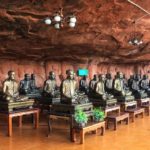Wat Phu Tok: Must See Temples in Northeast Thailand
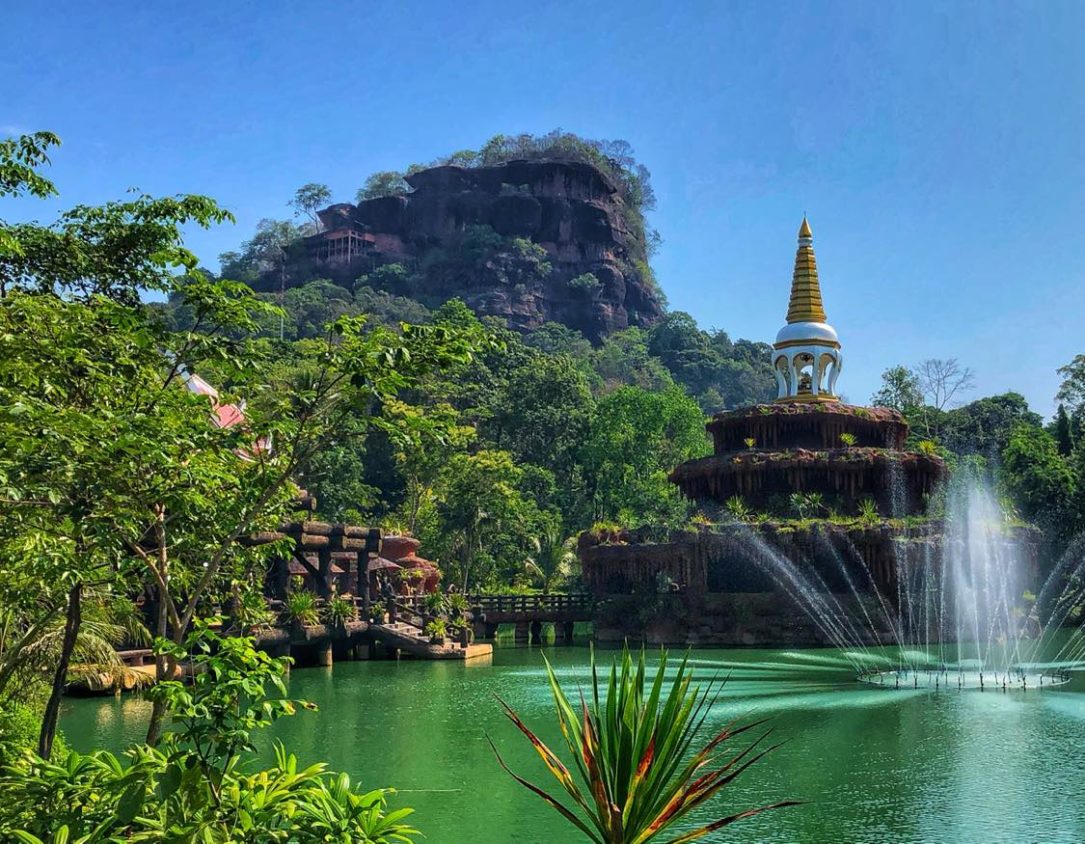
If you were to make a bucket list of “must see” temples in Thailand, Wat Phu Tok (วัดภูทอก) in Bueng Kan should be on it. This legendary Isan temple is known for its stunning cliffside location and the challenging pilgrimage that devotees must take to reach the summit.
Wat Phu Tok has been described as the most dangerous, most thrilling, scariest temple in Thailand. That is true if you are afraid of heights and perilous walkways. However, even if you are scared of heights, Wat Phu Tok should be on your list of must-see Thai temples.
While famous for its maze of rickety wooden staircases, made without the use of any modern machinery or advanced engineering, Wat Phu Tok does have a path that’s far less likely to freak people out, unless you suffer from serious vertigo. But more on that later.
Who Built Wat Phu Tok in Bueng Kan?
The story of Wat Phu Tok begins with its creator: Phra Ajarn Juan Kulchetto (พระอาจารย์จวน กุลเชฏโฐ). Ajarn Juan was born in 1920 and ordained as a Buddhist monk in 1941. After temporarily leaving the monkhood, he again became ordained in 1943. In 1946, he had the privilege to study under Ajarn Mun Bhuridatta Thera, co-founder of the forest tradition of Thai Buddhism, and one of Thailand’s most venerated monks.
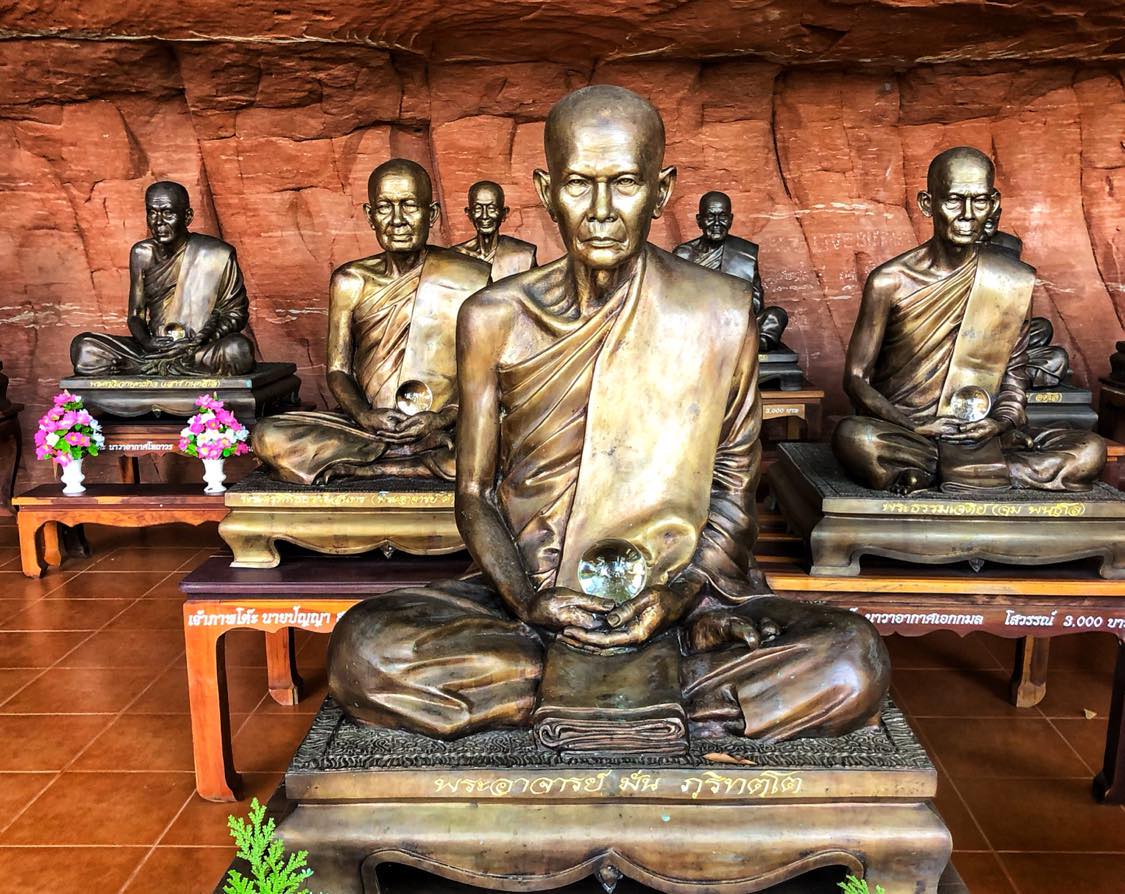
Ajarn Juan (pronounced ah-jahn choo-un) followed in the footsteps of his famous mentor. He spent much of his time in seclusion in the woods, walking the forests and sleeping in caves. His spiritual pilgrimage took him not only through the forests of Northeastern Thailand, but also in the North of Thailand around Chiang Mai. Throughout this period he often would have strange dreams and visions.
During the early 1960s, Ajarn Juan almost was assassinated when he was mistakenly identified as a terrorist monk who supported the communist movement, which was becoming popular in Northeast Thailand. Ajarn Juan convinced the assassin that it was absurd that he was a communist, since communists were atheists and he was a follower of the Buddha. The assassin eventually repented and convinced officials that they had nothing to worry about with this devout forest monk.
In 1969, Ajarn Juan began visiting the Phu Tok area in Bueng Kan (บึงกาฬ), a province which borders the Mekong River and Laos to the north, and Sakon Nakhon, Udon Thani, and Nakhon Phanom to the south. The Thai phrase Phu Tok (pronounced phoo-tawk) means “lonely mountain” in the Isan language. The area consists of two isolated sandstone mountains, Phu Tok Yai and Phu Tok Noi, which rise up seemingly inexplicably from the surrounding, more level, forest terrain.
When Ajarn Juan arrived to the area, he found Phu Tok Noi caves which were perfect for meditation and protection from the elements. However, there were no dams or reservoirs, and the streams dried up during the hot season. So, he had live off the water that lingered in the rock and cave basins.
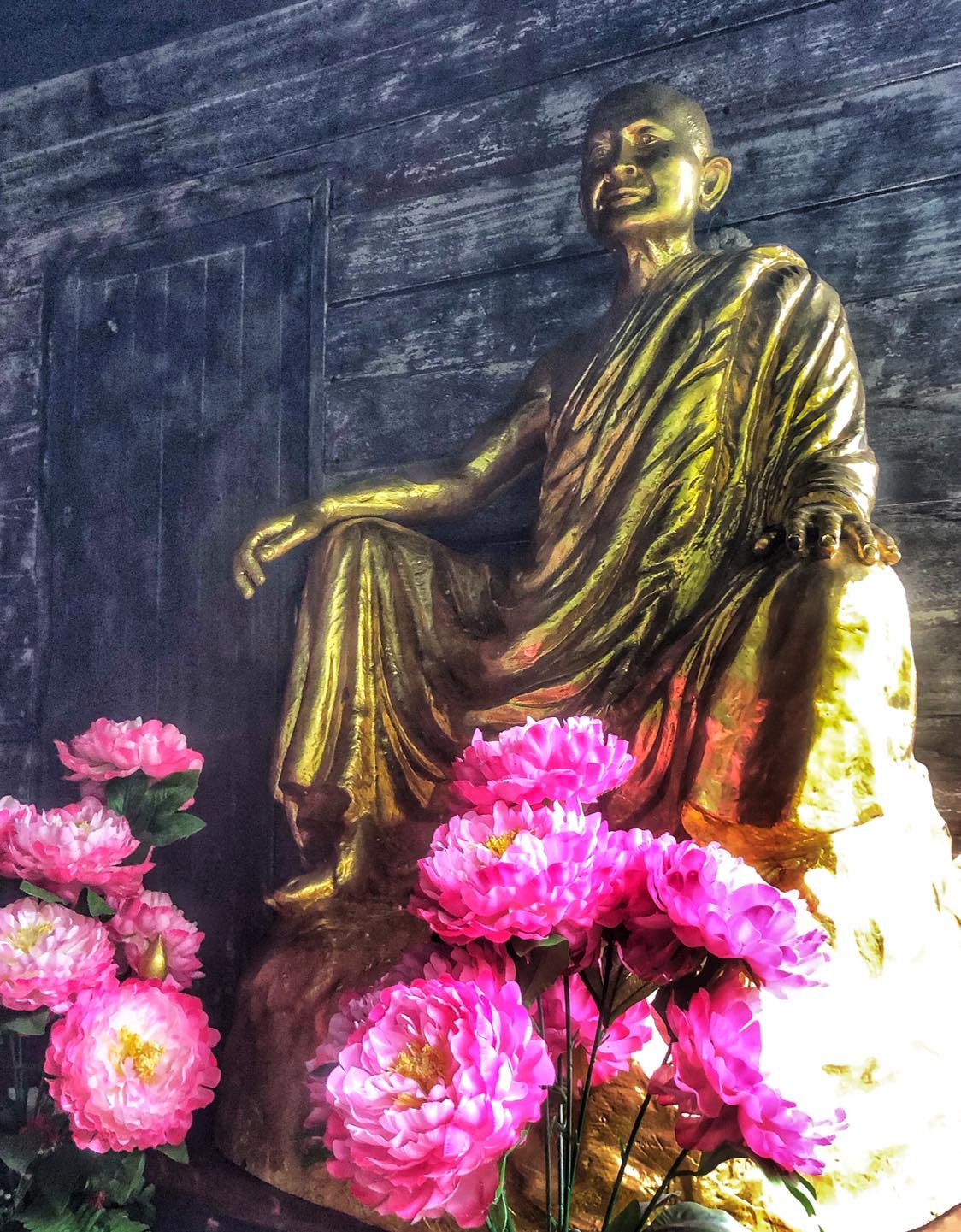
The History of Wat Phu Tok
In 1969, Ajarn Juan began visiting the Phu Tok area in Bueng Kan (บึงกาฬ), a province which borders the Mekong River and Laos to the north, and Sakon Nakhon, Udon Thani, and Nakhon Phanom to the south. This forested area of Bueng Kan consists of two isolated sandstone mountains, Phu Tok Yai and Phu Tok Noi, which rise up seemingly inexplicably from the surrounding, more level, forest terrain.
When Ajarn Juan arrived, he found Phu Tok Noi’s caves perfect for meditation and protection from the elements. However, there were no dams or reservoirs. The streams dried up during the hot season. So, he had live off the water that lingered in the rock and cave basins.
Ajarn Juan soon led the villagers in building a dam to store water during the rainy season. He also was joined by 2 other monks, and the construction of what would become Wat Phu Tok began. They started by building a few huts (kutis) to live in at the lower levels. During the building of these huts, Ajarn Juan would climb vines up to the 5th level to sleep in the cave located there. This cave is now called “Phra Wihan Cave” (which translates to Cave of the Buddha Image). It is the location of the temple’s most important Buddha statue.
During the rainy season on 1969, local villagers (who were very poor in resources but strong in faith) built the first wooden staircases up to the 5th and 6th levels of Phu Tok Noi, so that Ajarn Juan would no longer have to climb the vines.
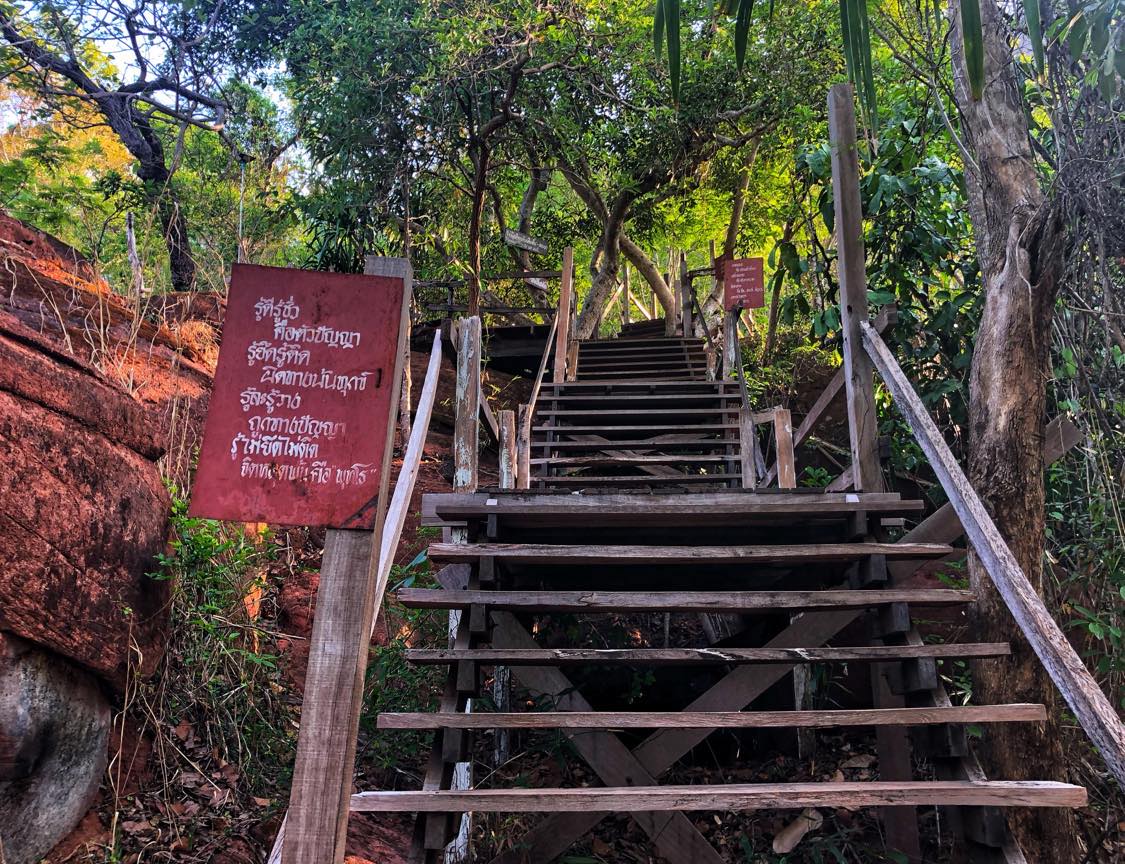
The novices who had joined the Ajarn Juan at Wat Phu Tok were often quite sick during this first year. They complained of being haunted by the deity of the mountain, who told them that they were stealing his castle. Ajarn Juan admonished the young monks, telling them to remember their holy precepts, to cultivate perseverance and spread kindness, and never underestimate the power of these actions.
Soon after, Ajarn Juan had a vision where an angel came to him and said: “I bow down and give you this mountain to take and keep. We will go down to the bottom. However, please always speak with kind words, don’t make loud noises, behave appropriately, and don’t toss debris down upon us.”
After that vision, life at Wat Phu Tok prospered. In 1970, a pavilion was built on the 5th level and a principal Buddha image installed. The following year, a wooden bridge around the 5th level cliffside was completed. Improvements such as new dams continued. And in 1974, cliffside bridges on the 4th and 6th levels were added.
Early in the construction process, Ajarn Juan had consulted with an American architect about the feasibility and cost of building the mountainside temple. But the architect had quoted a price so high that Ajarn Juan decided to proceed by using traditional methods only, with no help from modern machinery or engineering.
By 1980, Wat Phu Tok, also known as Wat Chetiya Khiri Wihan (วัดเจติยาคีรีวิหาร), had been completely established. Staircases had been built to access the 6 levels of the cliff, not including 7th level summit. Walkways had been built into the sides of the cliff, providing a 360 degree panoramic view of Bueng Kan.
In addition, six dams had been constructed; toilets and bathrooms for the public were installed; and a road was built around Phu Tok Noi and Phu Tok Yai, as well as Phu Sing Noi, which is located about 8 kilometers north. These three sandstone mountains now form a protected triangle of monasteries and forest reserves filled with wildlife and exotic plants.
Ajarn Juan tragically died in a plane crash on April 27th, 1980, at the age of 59, while flying to Bangkok. Ever since his death, Wat Phu Tok has continued to be maintained and developed in the traditional and respectful way that he established during his lifetime.
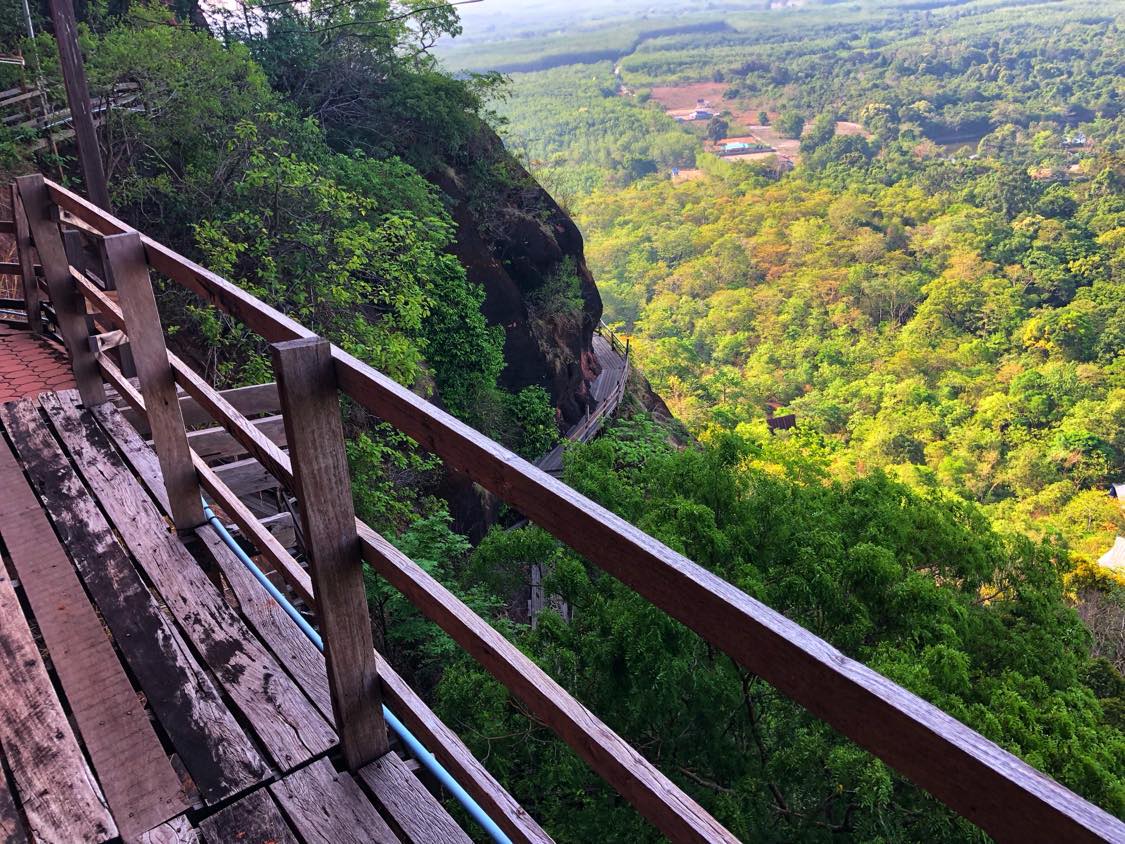
Wat Phu Tok Architectures & Features
Wat Phu Tok has 7 levels which correspond to the 7 stages of awakening that lead to Nirvana. These stages are the path of virtue or “path of the dharma” (wisdom of the Buddha). They are not necessarily linear, and can occur in a different order or simultaneously (except for the final stage of Nirvana).
Mindfulness: A growing awareness of your thoughts, emotions, and actions, while seeking to align them with the principles of compassion, kindness, and non-harm.
Overcoming Doubt: Doubt and uncertainty are major obstacles to spiritual enlightenment. In this stage, you overcome your doubts and develop a sense of confidence and faith in the path.
Overcoming Distractions and Laziness: You must confront the distractions and obstacles that hinder your progress. By doing so, you will develop a greater sense of determination and focus. This will enable you to overcome laziness and cultivate greater discipline.
Developing Concentration: With your mind becoming more focused and disciplined, you will begin to develop greater levels of concentration. This allows you to penetrate deeper into the nature of reality and cultivate insight into the true nature of the self.
Developing Insight: Deeper insights into the true nature of reality are attained. You begin to understand the impermanence and emptiness of all phenomena and cultivate greater wisdom and understanding.
Overcoming Attachment: The spiritual seeker must confront the attachments and cravings that cause his or her suffering. Only then can you begin to let go of your attachment to these sources of suffering.
Attainment of Nirvana: The final level is the attainment of Nirvana, which represents the ultimate liberation from suffering. This is achieved through a complete understanding of the nature of reality and the attainment of perfect wisdom and compassion.
At Wat Phu Tok, the 6 wooden staircases and walkways that wind their way around the 6 levels of the mountain are thus referred to as the Heaven and Hell Bridge, or Sapaan Narok Sawan (สะพานนรก-สวรรค์), which translates to the “Bridge from Hell to Heaven”.
The monks who maintain Wat Phu Tok are careful to remind visitors that this is not an ordinary Thai tourist attraction, but a place for quiet meditation and contemplation, while testing your fitness levels and confronting your doubts about the safety of the planks on which you walk, which if they fail could send you tumbling into an abyss.
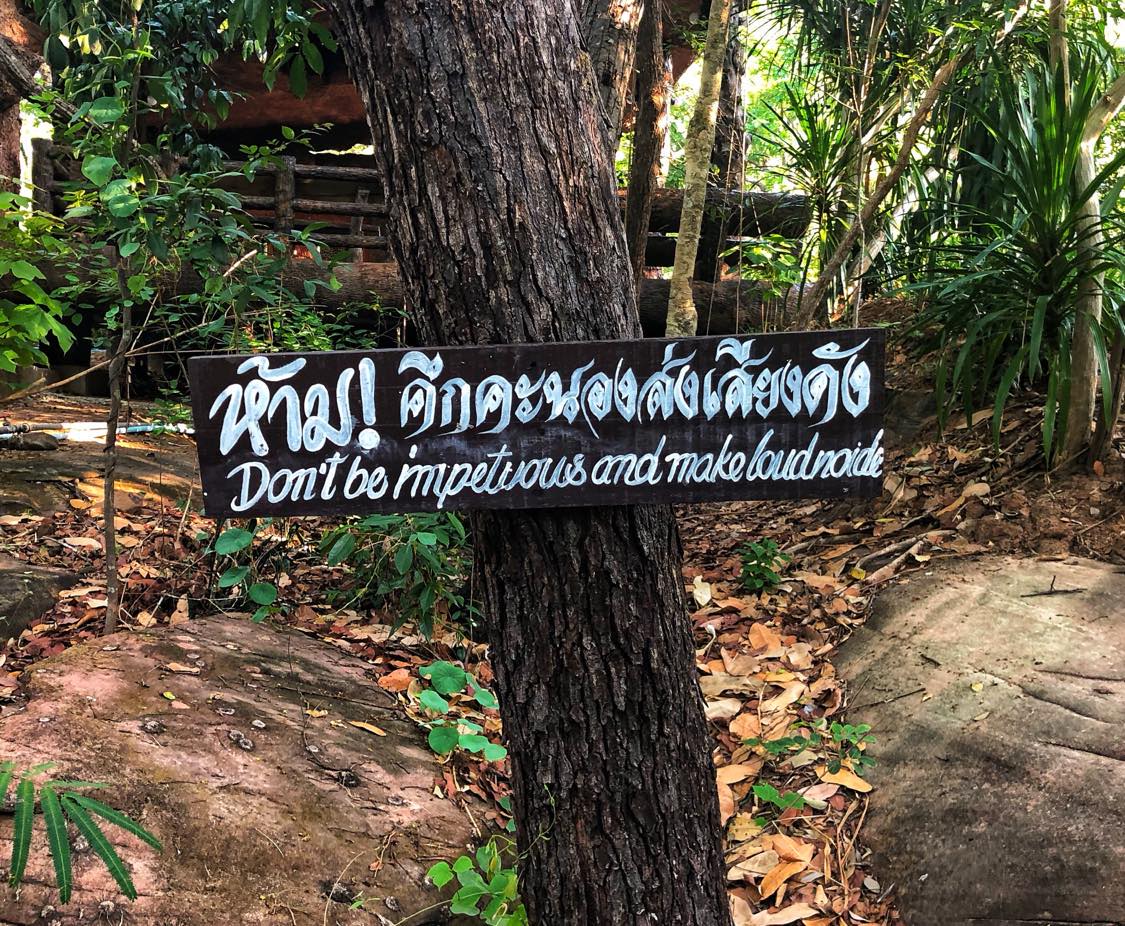
After you walk through the stone gate to the 1st level, you’ll see signs with such admonitions as “Don’t be impetuous and make loud noises” and “Be conscious of every step that you take” and “This is a place to practice the dharma.”
The first 3 levels of Wat Phu Tok are easy to navigate, and there is lovely natural scenery to enjoy. It is when you arrive at the 4th level that things get a bit trickier and require higher levels of fitness and courage. At the staircases which lead to the 4th level, you’ll be given a choice of going up a staircase to the left or a staircase to the right.
The left (Western) path around Wat Phu Tok is the path to take if you have a fear of heights or are uncertain whether you want to take the most precarious walkways around the cliffside. Take note that you will have a chance to walk on these more dangerous and thrilling walkways later, if you’ve screwed your courage to the sticking post and conquered your fears.
The Western path around Wat Phu Tok is also the best way to avoid heat exhaustion, and inadvertently falling over a railing due to heat stroke. Wat Phu Tok is 390 meters above sea level, and densely forested. There are no cool breezes during the hot season, which is when we visited. The heat can be quite brutal. To escape this intense heat, schedule your visit for early in the morning (6:30 am or later), and take the shaded left side path.
If you take the Eastern staircases to the 4th level, you’ll soon arrive at the more perilous walkways that go around the mountain’s side, while also facing the morning sun. The Western shaded path will take you to shortcut to arrive at the 5th level, where is found the temple’s main Buddha shrine, as well as monks’ living quarters.
When you reach the 5th level via the Western path, you can walk Eastward to reach the most precarious wooden walkways of Wat Phu Tok. We would suggest taking this route for a little while, even if you are afraid of heights, as the first walkways are not that scary. You can stop later and turn back if things begin to get too dicey for you.
However, if you do have the courage to continue Eastward around the mountain side, you will be rewarded! Not just for confronting your fears but for arriving at a stone pathway that leads to a large boulder and small pavilion that supposedly contains relics of the Buddha, along with a statue of Ajarn Juan. This pavilion is known as the Temple of the Buddha. It the best spot to get close but expansive photograph of Wat Phu Tok and its cliffside staircases.
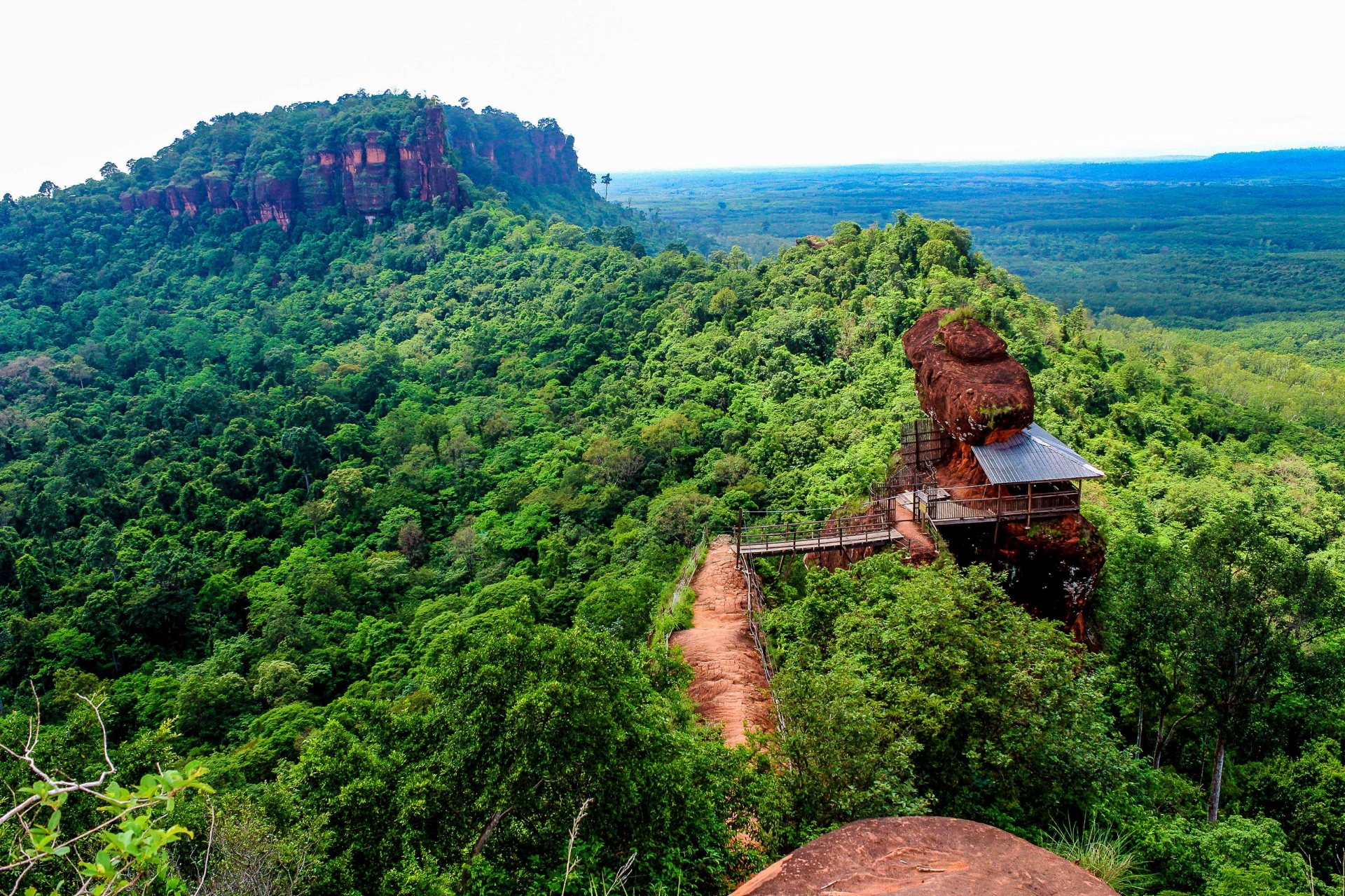
Walking westward from “Phra Wihan Cave” on Level 5, you’ll meet another large gold statue of Ajarn Juan. Then you’ll descend a little and arrive at a large cave filled with dozens of bronze statues of notable Thai monks, with the legendary Ajarn Mun Bhuridatta Thera at the head of the revered entourage.
Walking onward you’ll arrive at the staircase to the 6th level of Wat Phu Tok. Here there is cave entrance to a large Naga serpent that is believed to live in the mountain. Nagas play the role of protector in Thai Buddhism, and several areas in Northeastern Thailand are said to be where they make their home — other prominent places being the Mekong River in Nong Khai and Nong Han Lake in Sakon Nakhon.
The summit of Wat Phu Tok is the 7th level, and one which only a few people seek to climb — which seems fitting since the 7th level represents Nirvana. There are no staircases to reach the 7th level, and it’s allegedly infested with snakes. To get there, you mist climb up a tricky path, grabbing onto tree roots for help, and making sure that one those roots isn’t actually a snake.
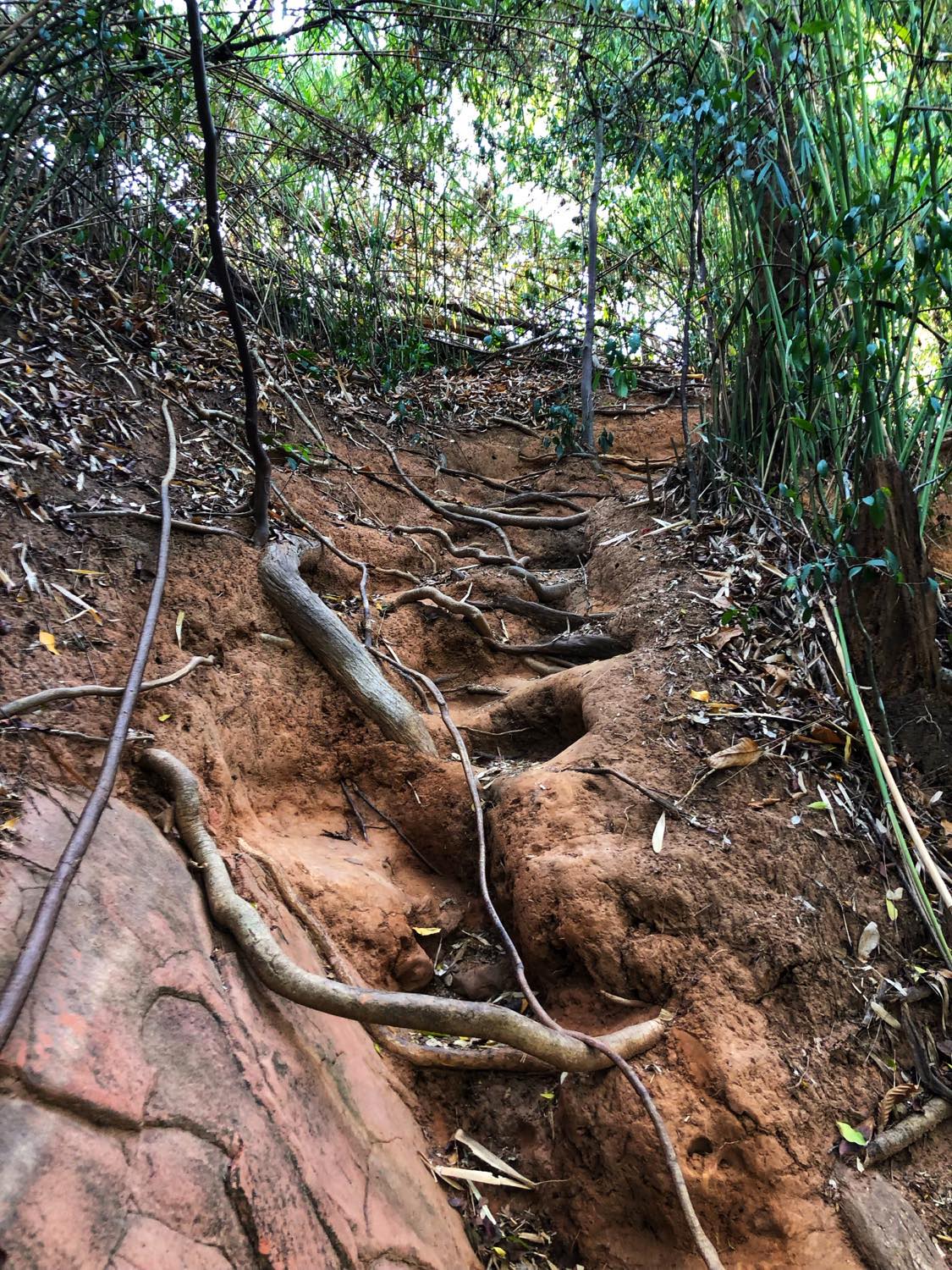
We would suggest only the spiritually and physically fit visitors make the attempt. If you do arrive at the 7th level successfully, there is lovely, winding path through the rooftop forest. Staying on a leftward course, you’ll end up at the far Western edge of Wat Phu Tok, where there is a curious laterite stone topped with coins that have been set upon it for good luck and abundance. The mountain view from here is spectacular, and you’ll also enjoy an elevated view the large boulder and Temple of the Buddha described earlier.
When you descend from the 7th or 6th levels, you can decide again at Level 5 whether you want to take the eastward, precarious walkways down Phu Tok Noi mountain, or go back the way you came. When you arrive at the bottom and head back to your vehicle, be sure to the two pagodas that are not far from the temple’s parking lot.
You’ll see a cave like pagoda, surround by a pond with fountain, which honors the Buddha and Ajarn Juan’s early days of living in the caves of Phu Tok Noi. And an 8 ringed, marble pagoda that houses the relics of Ajarn Juan and artifacts from his life as the architect and founder of Wat Phu Tok.
The 8 octagonal rings of the Ajarn Juan memorial chedi represent the 8 fold path of Buddhism. These are similar to the 7 stages of awakening that Wat Phu Tok symbolizes and include: right understand, right intention, right speech, right action, right livelihood, right effort, right mindfulness, and right concentration. The octagonal base of the chedi has gorgeous and intriguing terracotta scenes of Buddhist life in bas relief. The color of the terracotta was fashioned to resemble the color of the stones at Phu Tok Noi.
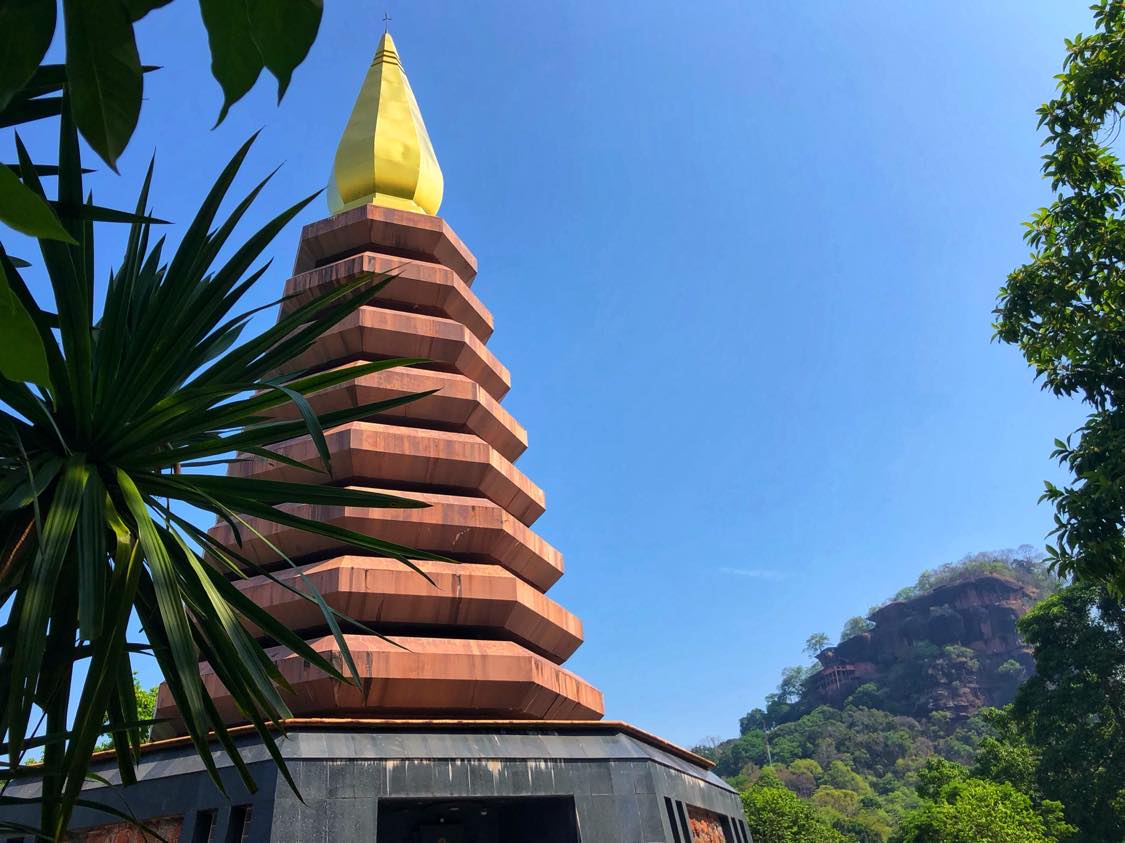
While Wat Phu Tok is a well-known temple in Northeastern Thailand, it attracts relatively few visitors compared to the famous temples of Bangkok. We arrived on a Tuesday morning at 7:30 am and had the entire 7 levels of the temple to ourselves, giving us a perfect opportunity to explore the mountain in peace and quiet contemplation. It undoubtedly receives more visitors on weekends, but for those who seek a Thailand spiritual retreat, Wat Phu Tok should be high on your list.
How to Get to Wat Phu Tok
Traveling from Sakon Nakhon, it takes about 2:15 hours to arrive a Wat Phu Tok, making it a wonderful place for a day trip. If you are planning an Isan vacation and traveling from Bangkok, we recommend taking the approximate 1 hour flight to the Sakon Nakhon airport, and making Sakon Nakhon your home base for your vacation. You can then rent a car or hire a driver to take you to Wat Phu Tok.
There is no airport in Bueng Kan. So, your only other options are to take a 15 hour (900 baht) bus drive from Bangkok to Bueng Kan. Or you could fly into Udon Thani airport and hire a car or driver to take you to Wat Phu Tok. But Sakon Nakhon is closer to Wat Phu Tok than Udon Thani, and with its beautiful mountain and forest temples, it is the best place to use as a home base for a tour of Northeastern Thailand (Isan).
Other Temples Nearby
If you are planning a day trip to Wat Phu Tok from Sakon Nakhon, you’ll likely arrive early in the morning and finish your visit in around 2-3 hours. So, you’ll have some additional time for site seeing in Bueng Kan before driving back. You’ll likely be hungry after your adventure on the mountain. So, we suggest packing yourself a picnic lunch, rather than trying to find a nearby restaurant or noodle shop.
You’ll remember that we mentioned the three mountains of Phu Tok Noi, Phu Tok Yai, and Phu Sing Noi. The monastery grounds at Phu Tok Yai are not currently open to the public, and now serve only as a residence for monks. However, the temple at Phu Sing Noi is open to the public and is named Wat Pa Phu Sing Nam Thip (วัดป่าภูสิงห์น้ำทิพย์). This temple also requires some staircase climbing (but nothing compared to Wat Phu Tok)
Wat Pa Phu Sing Nam Thip is only about a 20 minute drive from Wat Phu Tok, and definitely worth the visit. You’ll enjoy additional lovely views here, exotic natural wonders, as well as interesting Buddhist and Hindu sculptures. On your way there, you can also stop in at a Buddhist temple named Wat Pa Khiri Wong (วัดป่าคีรีวงศ์), which is a small, peaceful temple with three, friendly resident monks..
- The 1st English Dhamma Talk Project, Sakon Nakhon Thailand - July 8, 2025
- Affirmations in Buddhism & Thailand - June 7, 2025
- Speak Thai Naturally Without the Gymnastics - April 20, 2025

